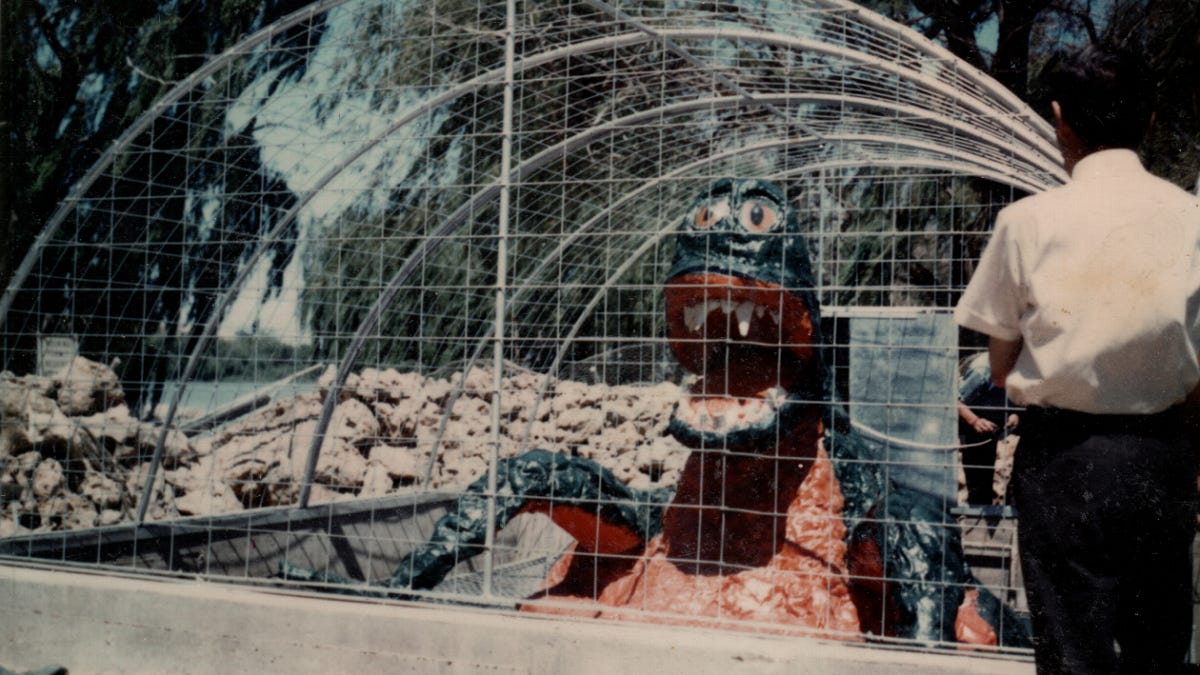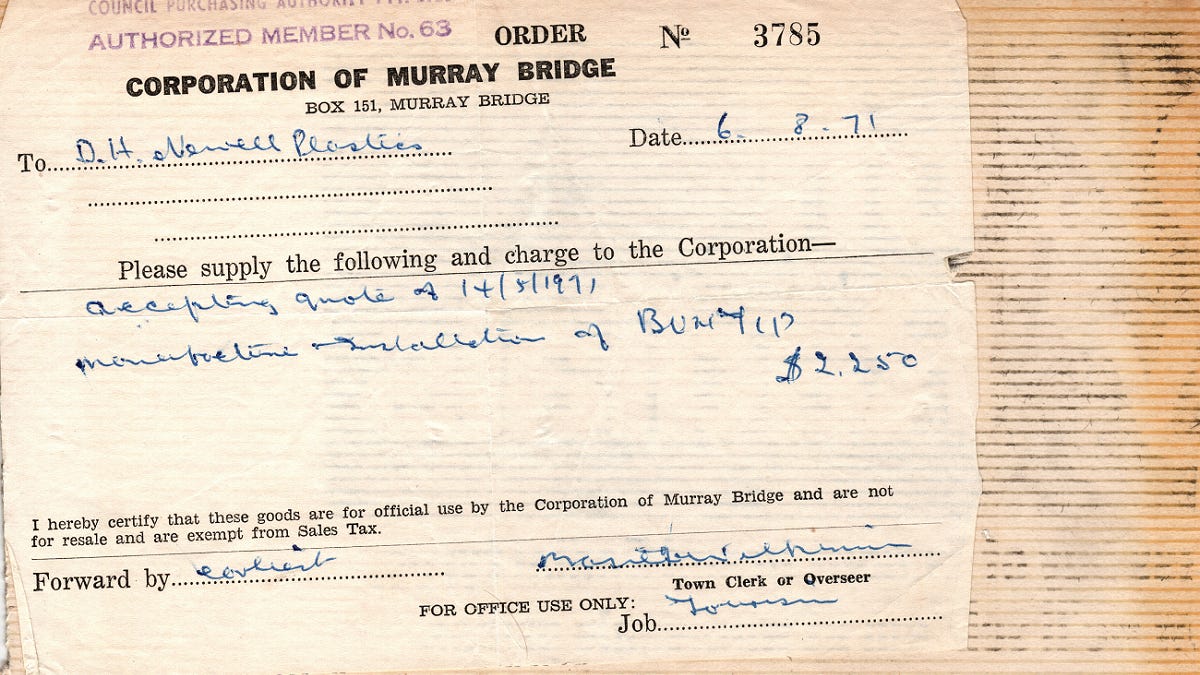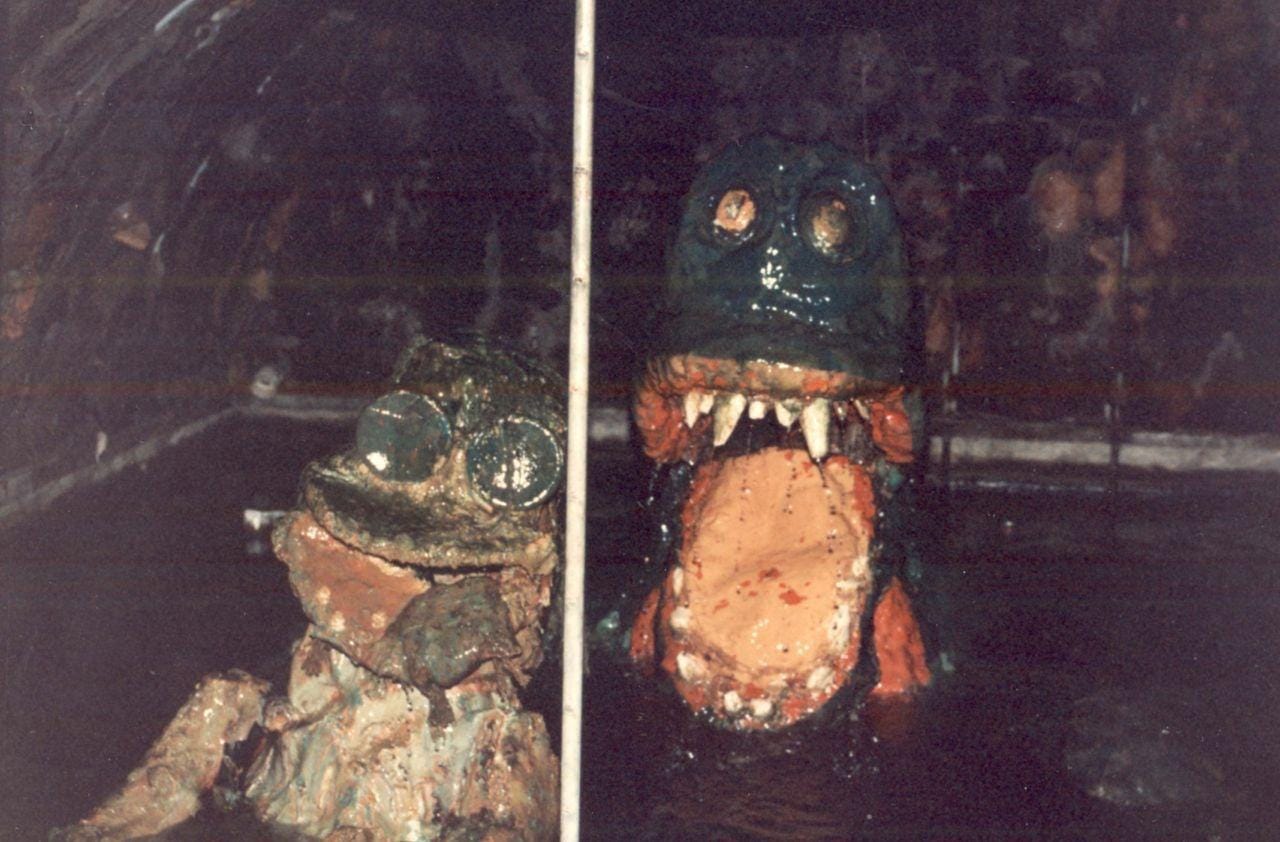Murray Bridge bunyip at 50: How Dennis Newell’s monster became an icon
Exclusive: For Bertha’s 50th birthday, Murray Bridge News presents the definitive history of the animatronic horror at Sturt Reserve, with help from the Newell family.
This story was originally published behind Murray Bridge News’ paywall. Paywalled stories are unlocked four weeks after publication. Can’t wait that long? Subscribe here.
“I, Dennis Newell, am the proprietor of a moulded plastics firm in Murray Bridge.”
“I am a member of the organising committee for the Murray Bridge Weerama Festival, for which I have created the festival bunyip based on the character in the book The Monster of Murray Bridge.
“The above is the truth and nothing but the truth.”
Mr Newell wrote those words in 1972, the year the world was introduced to the animatronic monster which sprung from Ngarrindjeri legend, via his brain, onto Murray Bridge’s riverfront.

Ever since its official opening by Premier Don Dunstan on January 29 – 50 years ago last Saturday – it has remained an attraction for generations of terrified children and their grinning parents, one of the first things that comes to the minds of people around Australia when they think of Murray Bridge.
Here, with help from the Newell family, Murray Bridge News tells the definitive story of how the bunyip came to be.
To find its origins, we begin much further back in time.

‘We don’t dream these stories up – they’re creation stories’
The story of the mulyawonk has been passed down by Ngarrindjeri tradition for tens of thousands of years.
It was described in legend as a half-man, half-fish creature, Rita Lindsay recalled at Sturt Reserve on Saturday.
“Our creation story talks about how he was a greedy man who set too many nets, caught too many fish, and didn’t leave any for the elders or the people further down the stream,” she said.
“In our story, he was changed into the mulyawonk because he was greedy, but now he protects the river, he protects the fish.
“It’s a story that teaches us not to be greedy, take only what you need, (and that) whatever happens upstream is going to affect downstream.”
The robotic version attracted criticism from Ngarrindjeri soon after it was installed, when elders complained to The Advertiser that it looked nothing like the black, hairy creature described in local legend.
Uncle Major Sumner argued just last year that the creature was not scary enough.
After all, Mr Newell always intended it to attract people, not scare them away.
‘Everyone thought he was a little bit crazy’
Bert the bunyip was first conceived as a gimmick to promote the Weerama Festival, held on the Australia Day long weekend each year.
He would be put in a cave and rise from the water with a roar whenever someone dropped in 20 cents.
The idea was something of a compromise for Mr Newell, who had originally hoped to build a $750,000 theme park called Dreamtime Land at the southern end of Sturt Reserve.
Murray Bridge’s councillors agreed to the bunyip plan on August 2, 1971 by a majority of just one vote, that of Mayor EW Doecke.
The council paid $2250 for the attraction, supported by a $500 donation from the local Jaycees club.

Councillors considered installing the bunyip at Diamond Park or beside a bowling green before settling on a spot at Sturt Reserve, a few hundred metres downstream from the SA Farmers Union dairy factory.
Alongside Steriline engineers Tony Sims and Ray and James Rossiter, Mr Newell spent many nights in a shed in late 1971, bringing his creation to mechanical life.
“Everyone thought he was a little bit crazy,” Mr Newell’s wife Marlene said on Saturday.
“Dennis recalls much controversy emanating, with heaps of media comment and ratepayer meetings.”
But the bunyip became a huge drawcard as soon as it opened.
It raised thousands of dollars in its first year of operation, and Mr Newell did his best to capitalise, producing bunyip T-shirts and even writing to board game manufacturer John Sands to ask whether a bunyip-themed game might sell.
“Your idea would definitely be the most original Australian idea we have ever received,” wrote product manager WH Barrass in reply, but he declined the idea.
Mr Newell wound up making several other bunyips, too, including one for the 1972 Adelaide Festival.
Another was created for a theme park near Albury, New South Wales in about 1975.
The now-derelict Ettamogah bunyip, like Murray Bridge’s, rose out of a pond and moved around a bit, but looked more froggish.
In fact, it bore a distinct resemblance to the baby bunyip who came to live next to Bert – afterwards known as Bertha – on December 5, 1981.
Bertha and her son or daughter lived happily together in their cave until 2000.
Sometime that year, an act of vandalism led Bertha to have a major facelift, making her into the loveable – or memorable, at least – middle-aged bunyip she is today.
The baby bunyip has not been seen since.
Traditions come together at Bertha’s 50th birthday
On Saturday, more than 100 people turned out for Bertha’s 50th birthday bash at Sturt Reserve, an evening of Ngarrindjeri dance and storytelling, memory-sharing, food, live music and children’s activities.
Murray Bridge Mayor Brenton Lewis applauded the fact that the two traditions of the bunyip – the Ngarrindjeri legend and the somewhat tacky tourist attraction – could be celebrated at once.
“I think (it’s) a sign of maturity that we are moving forward as one community,” he said.

“We are totally respectful that there was tradition before 50 years ago, when the bunyip that we see behind us was created.
“I’d like you to see today like a coming-together, not leaving anyone behind.”
The local council has big plans to keep redeveloping Murray Bridge’s riverfront over the coming years, but every concept image includes the bunyip in pride of place somewhere.
There’s a new mulyawonk out on the River Murray these days, too.
A boat for Murray Bridge’s State Emergency Service unit was christened the Mulyawonk on Saturday, with champagne poured by Emergency Services Minister Vincent Tarzia and a prayer from Uniting Church minister Darren Lovell.
It will be used for river rescues, if needed.

Would it be a stretch to say the SES will carry on the work the legendary mulyawonk started thousands of years ago?
Perhaps.
Still, generations to come will continue to be reminded of the Ngarrindjeri story whenever they visit Murray Bridge.
And they don’t even need a 20-cent coin any more.
Just press the button, and there she’ll be.










Well done Rita and Michael on your Mulyawonk song written to celebrate the Mulyawonk story and lore. It was a good thing that the Rural City acted on advice and removed the outdated and wrong interpretation of the bunyip story replacing it with the Ngarrindjeri Mulyawonk story that has been handed down generations upon generations and is still very much at the core of Ngarrindjeri story telling. And what a fine story it is telling all not to be greedy by catching more fish that you can eat and to always be water safe when in the lower Murray and Lakes.
i went inside the cage is that allowed